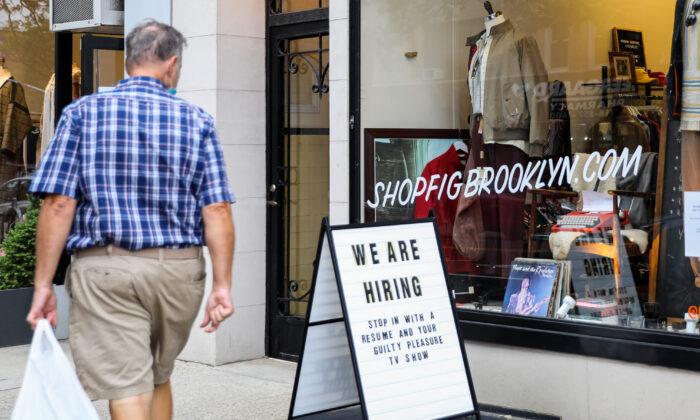WASHINGTON—The U.S. job market showed a burst of strength in October, with employers adding 638,000 jobs and the unemployment rate tumbling to 6.9 percent. Still, the pace of hiring isn’t enough to rapidly soak up the millions of Americans who were thrown out of work by the pandemic recession.
The job gain suggested that a tentative economic recovery is still intact even as it faces a surging viral outbreak. October’s increase was slightly below the 672,000 jobs that were added in September and far fewer than the 1.5 million in August. But last month’s gain was stronger than it appears: It was held down by the loss of about 150,000 temporary Census jobs.
Excluding government, businesses added a healthy 906,000 jobs. Job growth was particularly strong in construction, retail, and a category that includes restaurants and hotels.
The report Friday from the Labor Department said the unemployment rate sank a full percentage point from 7.9 percent in September. Still, the nation now has 10.1 million fewer jobs than it did before the pandemic intensified in March.
At the current pace of hiring, it would take until February 2022 to regain the jobs lost to the pandemic. That would be faster than the 2008–2009 Great Recession, when it took more than five years to recover the jobs eliminated in that downturn.
Yet it’s far from clear that employers can maintain—let alone increase—their pace of hiring. The job market and the overall economy are under intensified pressure from the accelerating pandemic. On Thursday, the nation broke another record in the seven-day rolling average for new cases, hitting nearly 90,000. Daily new cases were also on track for another day above 100,000, with surging numbers reported all around the country, including a combined nearly 25,000 in Texas, Illinois, and Florida.
And the longer that unemployment remains elevated, economists worry, the harder it will be for many of those out of work to find jobs. Employers are often reluctant to hire people who have been unemployed for months.
“It was a pleasant surprise to see that the pace of the recovery hasn’t slowed down,” said Nick Bunker, an economist at Indeed, the job search website. “But we all need to keep in mind the huge hole that we’re in, in terms of jobs and unemployment.”
The economy, which had rebounded sharply in the July-September quarter as businesses reopened from virus-related shutdowns, is now expanding more slowly. Many businesses, especially restaurants and bars that had made use of outdoor seating, may struggle as the weather turns colder. Consumers could also pull back again on shopping, traveling, and other activities to avoid contracting the virus.
Friday’s report follows the expiration of government stimulus for struggling individuals, businesses, and state and local governments and the failure of Congress to provide further aid.
That stimulus included $1,200 checks that were sent to most adults in the spring and a $600-a-week federal jobless benefit that expired in July. That was followed by an additional $300 that lasted through mid-September. A study by JPMorgan Chase found that Americans spent roughly two-thirds of such money by the end of August.
Jerome Powell, chair of the Federal Reserve, warned Thursday that the pandemic could pose a worsening threat to the economy.
“People who have maybe begun to engage in activities that they haven’t—flying, staying in a hotel, going to restaurants, going to bars ... they may pull back in a situation where suddenly the cases are everywhere in your city, your state, your community,” the chairman said at a news conference after the Fed’s latest policy meeting.
Powell acknowledged that the pandemic didn’t harm the economy in the summer as much as many had feared it might, partly because the multi-trillion aid package that Congress enacted provided “essential” support.
Some large companies are still shedding workers. ExxonMobil said late last month that it would cut 1,900 jobs, mostly at corporate headquarters. Chevron has said it will cut about a quarter of the employees from its newly acquired unit Noble Energy. Boeing said it expects to cut its workforce by 30,000 to 130,000.
Still, some parts of the economy are recovering steadily. Manufacturing output is still rebounding, with Americans stepping up their purchases of cars, homes, and housing-related goods like appliances and furniture. Home sales have also jumped.





